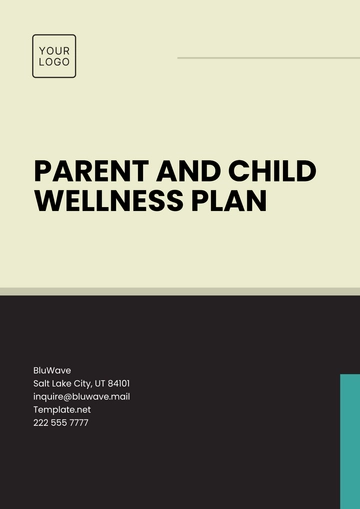Free Mental Health Wellness Plan Format

Prepared by: [Your Name]
Company: [Your Company Name]
Date: [Insert Date]
I. Introduction
Mental health is a cornerstone of overall well-being, impacting every aspect of life, including relationships, work, and physical health. This Mental Health Wellness Plan provides a structured approach to maintain and improve mental health through proactive strategies, resources, and support systems.
II. Purpose and Objectives
Purpose:
To support individuals in developing and sustaining mental health practices that enhance resilience, emotional well-being, and the ability to cope with life's challenges.
Objectives:
Identify personal mental health needs and challenges.
Develop healthy coping mechanisms and self-care strategies.
Foster emotional resilience and stress management skills.
Create a supportive environment for mental health growth.
Encourage access to professional mental health resources as needed.
III. Core Components of the Wellness Plan
A. Mental Health Assessment
Current Emotional State:
Reflect on current feelings and emotional challenges.
Identify triggers that contribute to stress or negative emotions.
Strengths and Resources:
Highlight personal strengths, coping skills, and existing support systems.
Areas for Improvement:
List aspects of mental health that require attention, such as stress, anxiety, or work-life balance.
B. Goal Setting
Short-Term Goals:
Example: Practice mindfulness for 10 minutes daily.
Example: Reduce screen time before bed to improve sleep quality.
Long-Term Goals:
Example: Build a habit of regular physical exercise to support mental health.
Example: Strengthen relationships by dedicating time for meaningful conversations.
C. Self-Care Strategies
Physical Self-Care:
Incorporate regular exercise such as walking, yoga, or swimming.
Ensure proper nutrition and hydration.
Establish a consistent sleep routine.
Emotional Self-Care:
Journal daily to process emotions.
Practice gratitude by listing three positive things each day.
Engage in creative outlets such as art, music, or writing.
Social Self-Care:
Schedule regular check-ins with friends and family.
Join support groups or social clubs with shared interests.
Set boundaries to protect mental energy in relationships.
Professional Self-Care:
Maintain a healthy work-life balance by setting clear boundaries.
Utilize breaks during the workday to reset mentally.
Seek professional development opportunities to reduce job stress.
D. Stress and Anxiety Management
Relaxation Techniques:
Deep breathing exercises, progressive muscle relaxation, or guided imagery.
Mindfulness Practices:
Meditation, mindful eating, or grounding exercises to stay present.
Time Management:
Use tools such as calendars or to-do lists to reduce overwhelm.
E. Crisis Management Plan
Recognizing Warning Signs:
Examples: Persistent sadness, overwhelming anxiety, changes in eating or sleeping patterns.
Crisis Resources:
Contact information for local mental health hotlines and therapists.
Emergency contacts, including trusted family or friends.
Immediate Action Steps:
Reach out to a trusted individual.
Utilize calming techniques like deep breathing.
Seek professional help if symptoms persist.
IV. Implementation Plan
A. Daily Practices
Dedicate time each day to activities that promote mental well-being.
Track progress in a journal or mental health app.
B. Weekly Check-Ins
Reflect on accomplishments and challenges over the week.
Adjust goals or strategies as needed.
C. Monthly Reviews
Evaluate overall progress toward mental health goals.
Celebrate successes and identify areas for further growth.
V. Support and Resources
A. Professional Support
Therapists and Counselors:
Schedule regular sessions to address emotional challenges.
Support Groups:
Attend meetings with peers facing similar mental health concerns.
B. Community Resources
Local Organizations:
Example: Mental health advocacy groups or wellness centers.
Online Tools:
Utilize apps for meditation, mood tracking, or cognitive behavioral therapy (CBT).
C. Personal Support System
Family and Friends:
Maintain open communication about emotional needs.
Mentors and Coaches:
Seek guidance from trusted individuals for personal growth.
VI. Evaluation and Adjustments
A. Measuring Success
Use mood trackers or journals to monitor emotional progress.
Identify improvements in stress levels, relationships, and coping abilities.
B. Adjusting the Plan
Reassess goals every few months to reflect current needs.
Incorporate new strategies or resources as they become available.
VII. Conclusion
This Mental Health Wellness Plan provides a roadmap for nurturing emotional well-being and resilience. By committing to self-care, setting realistic goals, and seeking support when needed, individuals can achieve a balanced and fulfilling life. Remember, mental health is a journey, and every step taken toward wellness is a meaningful one.
- 100% Customizable, free editor
- Access 1 Million+ Templates, photo’s & graphics
- Download or share as a template
- Click and replace photos, graphics, text, backgrounds
- Resize, crop, AI write & more
- Access advanced editor
You may also like
- Finance Plan
- Construction Plan
- Sales Plan
- Development Plan
- Career Plan
- Budget Plan
- HR Plan
- Education Plan
- Transition Plan
- Work Plan
- Training Plan
- Communication Plan
- Operation Plan
- Health And Safety Plan
- Strategy Plan
- Professional Development Plan
- Advertising Plan
- Risk Management Plan
- Restaurant Plan
- School Plan
- Nursing Home Patient Care Plan
- Nursing Care Plan
- Plan Event
- Startup Plan
- Social Media Plan
- Staffing Plan
- Annual Plan
- Content Plan
- Payment Plan
- Implementation Plan
- Hotel Plan
- Workout Plan
- Accounting Plan
- Campaign Plan
- Essay Plan
- 30 60 90 Day Plan
- Research Plan
- Recruitment Plan
- 90 Day Plan
- Quarterly Plan
- Emergency Plan
- 5 Year Plan
- Gym Plan
- Personal Plan
- IT and Software Plan
- Treatment Plan
- Real Estate Plan
- Law Firm Plan
- Healthcare Plan
- Improvement Plan
- Media Plan
- 5 Year Business Plan
- Learning Plan
- Marketing Campaign Plan
- Travel Agency Plan
- Cleaning Services Plan
- Interior Design Plan
- Performance Plan
- PR Plan
- Birth Plan
- Life Plan
- SEO Plan
- Disaster Recovery Plan
- Continuity Plan
- Launch Plan
- Legal Plan
- Behavior Plan
- Performance Improvement Plan
- Salon Plan
- Security Plan
- Security Management Plan
- Employee Development Plan
- Quality Plan
- Service Improvement Plan
- Growth Plan
- Incident Response Plan
- Basketball Plan
- Emergency Action Plan
- Product Launch Plan
- Spa Plan
- Employee Training Plan
- Data Analysis Plan
- Employee Action Plan
- Territory Plan
- Audit Plan
- Classroom Plan
- Activity Plan
- Parenting Plan
- Care Plan
- Project Execution Plan
- Exercise Plan
- Internship Plan
- Software Development Plan
- Continuous Improvement Plan
- Leave Plan
- 90 Day Sales Plan
- Advertising Agency Plan
- Employee Transition Plan
- Smart Action Plan
- Workplace Safety Plan
- Behavior Change Plan
- Contingency Plan
- Continuity of Operations Plan
- Health Plan
- Quality Control Plan
- Self Plan
- Sports Development Plan
- Change Management Plan
- Ecommerce Plan
- Personal Financial Plan
- Process Improvement Plan
- 30-60-90 Day Sales Plan
- Crisis Management Plan
- Engagement Plan
- Execution Plan
- Pandemic Plan
- Quality Assurance Plan
- Service Continuity Plan
- Agile Project Plan
- Fundraising Plan
- Job Transition Plan
- Asset Maintenance Plan
- Maintenance Plan
- Software Test Plan
- Staff Training and Development Plan
- 3 Year Plan
- Brand Activation Plan
- Release Plan
- Resource Plan
- Risk Mitigation Plan
- Teacher Plan
- 30 60 90 Day Plan for New Manager
- Food Safety Plan
- Food Truck Plan
- Hiring Plan
- Quality Management Plan
- Wellness Plan
- Behavior Intervention Plan
- Bonus Plan
- Investment Plan
- Maternity Leave Plan
- Pandemic Response Plan
- Succession Planning
- Coaching Plan
- Configuration Management Plan
- Remote Work Plan
- Self Care Plan
- Teaching Plan
- 100-Day Plan
- HACCP Plan
- Student Plan
- Sustainability Plan
- 30 60 90 Day Plan for Interview
- Access Plan
- Site Specific Safety Plan





























